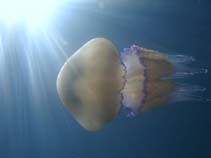Rhizostoma pulmo (Macri, 1778)
Barrel jellyfish
Classification / Names Common names | Synonyms | CoL | ITIS | WoRMS
Scyphozoa | Rhizostomeae | Rhizostomatidae
Environment: milieu / climate zone / depth range / distribution range Ecology
Pelagic; depth range 0 - 40 m (Ref. 122800). Subtropical; 46°N - 30°N, 5°W - 42°E (Ref. 121705)
Distribution Countries | FAO areas | Ecosystems | Occurrences | Introductions
Mediterranean and Black Sea: from Alboran Sea to Libya in the Mediterranean, east to Russia and north to Ukraine, Black Sea.
Length at first maturity / Size / Weight / Age
Maturity: Lm ?, range 12 - 15 cm Max length : 90.0 cm WD male/unsexed; (Ref. 358); common length : 60.0 cm WD male/unsexed; (Ref. 358)
Short description Morphology
Diameter of about 60 cm, exceptionally 90 cm. The sunshade is very bent, sometimes even higher than broad; the periphery is deprived of tentacles, replaced by approximately 80-90 lobes distributed on the entire circumference. One counts 8 very long oral; only braided arms towards their base; and comprising with milonguor of the appendices dermic in the cauliflower shape, while the ends smooth and are not ramified. Color: blue; yellow or pink milky; blue lobes ombrellaires with purple darker.
Largest in the Mediterranean, is rather not very irritant: the cnidocytes are slightly poisonous and do not transpierce the human skin; there is thus no risk of lesion. Euryhaline species (Ref. 122857). Found in a river estuary (Ref. 122860) and coastal lagoons (Refs. 81044, 122857). Abundant inshore but also found offshore (Ref. 122861).
Life cycle and mating behavior Maturity | Reproduction | Spawning | Eggs | Fecundity | Larvae
Members of the class Scyphozoa are gonochoric. Life cycle: Egg is laid by the adult medusa which later develops into a free-living planula, then to a scyphistoma to a strobila, and lastly to a free-living young medusa.
Main reference
References | Coordinator | Collaborators
Göthel, H. 1992. (Ref. 358)
IUCN Red List Status (Ref. 130435)
CITES status (Ref. 108899)
Not Evaluated
CMS (Ref. 116361)
Not Evaluated
Threat to humans
Human uses
Fisheries: commercial
| FishSource |
Tools
More information
Internet sources
BHL | BOLD Systems | CISTI | DiscoverLife | FAO(Publication : search) | Fishipedia | GenBank (genome, nucleotide) | GloBI | Gomexsi | Google Books | Google Scholar | Google | PubMed | Tree of Life | Wikipedia (Go, Search) | Zoological Record
Estimates based on models
Price category
(Ref. 80766):
Unknown.



